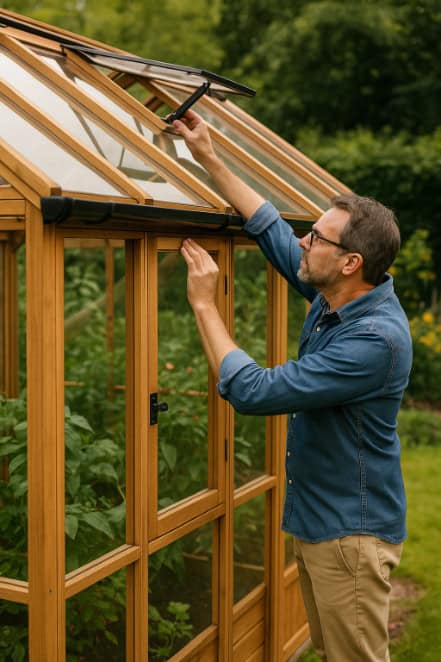Jump to:
Wooden greenhouse maintenance involves more work than those made of metal. Fortunately, it’s manageable even with a simple routine, and we’re here to help you keep a regular schedule.
This checklist is a great starting point—you can use it to plan out what needs doing and when, based on your setup. Ready?
Wooden Greenhouse Maintenance Starts With:

Checking the frame for damage
A big part of wooden greenhouse maintenance is keeping an eye on the frame itself. Around the base is where moisture tends to build up, leading to decay. If you spot dark patches, softness or wood breakdown, these are signs that rot has set in.
Splits and cracks are another common concern. These often occur when timber reacts to temperature and humidity changes outside. The joints and corners might need tightening or replacing if they’re loose or misaligned.
What to do: Check for standing water and clear debris that blocks water flow to keep moisture at bay. Sealing openings also prevents water from entering and causing them to get bigger. Replace a damaged board or secure a loose section to save you from bigger repairs later on.
Next is to…
Clean your greenhouse panels
The panels, supported by the frame, take the job of ensuring plants get the light they need. But over time, they accumulate dirt on the exterior and interior parts.
On the outside—rain, dust, algae, and even bird droppings can build up. Inside, you’ll often get condensation or mould, especially if there’s poor ventilation. All of these block sunlight, which your plants rely on, so keep them clean all the time, if possible.
Tip: Glass panels can handle more scrubbing, while polycarbonate can’t. Either way, we recommend using a soft cloth or sponge and avoiding harsh cleaners to be on the safe side.
Find more cleaning advice in our guide to cleaning a greenhouse.
Apply wooden greenhouse treatment
When it comes to treating, your focus area is the frame, as this will protect the structure from rot and decay. Ideally, this should be done once a year, usually in spring or early autumn when the weather’s dry.
Use a wood preservative that’s plant-safe, such as linseed oil and tung oil. A brush or spray will do the trick; get into the corners and anywhere water might sit. The bottom of the frame is usually the worst for damp, so don’t skip that.
It’s one of those jobs that takes a bit of time but saves you hassle later. The best time to do it is during the summer, when you can be nice and warm while doing the work, and right before your timber is likely to be affected by the cold. It will have a nice fresh protective coat.
Make sure your greenhouse is getting enough airflow
It’s easy to forget about airflow, especially if your greenhouse has built-in vents and does the job for you. But these vents can get stuck, blocked by leaves or dirt, or not opened often enough. See to it they’re doing what they’re meant to.
No vents? No problem. Take advantage of the greenhouse door (or roof windows if you have them) and open it during the day. Just doing this allows air to circulate inside and gives your plants a better shot at thriving without too much humidity.
Tip: If the space is large, consider investing in fans, like the oscillating type. The rotation helps move air around all the plants, rather than focusing on one area.
Clear out the gutters (if fitted)
Clogged gutters with leaves and debris can lead to pooling water around the bottom. That’s exactly where you don’t want it, as it’s a common spot for rot to kick in.
Have a quick look every couple of weeks, especially in autumn when leaves are everywhere. You can use a small trowel or your hands (gloves on) to clear it out. Run some water through to check it’s all flowing as it should.
While you’re there, give the downpipe a once-over, too. If it’s stuffed, you might need to tweak its angle or add an extension.
Do a quick check each season
Each season throws up its maintenance jobs. Spring for instance, is a good time to spot any damage from winter. Check for loose panels, signs of rot, and anything that might need resealing. It’s also the best time to prepare your garden for spring.
Summer is all about airflow. Make sure your vents are opening as they should, and that your plants aren’t too crowded. Autumn brings the leaves, so clear them out. This is also a handy time to top up your wood treatment before things get wet and cold.
Winter means keeping an eye on water and ice. Clear any snow off the roof if it piles up, and check around the base for pooling. Look for draughts or broken seals while you’re at it.
You can find more tips here if you’re dealing with heavy snow build up: How to Clear Snow from Driveway and Garden
Round-up
Wooden greenhouse maintenance might seem like a lot, but it comes down to keeping up with a few basics. The more regular you are with it, the less likely you’ll run into bigger problems down the line.
We hope this checklist has given you ideas, and feel free to adjust it it to what works for you!
Up next on your reading list: Greenhouse Ventilation: Aspects to Consider





